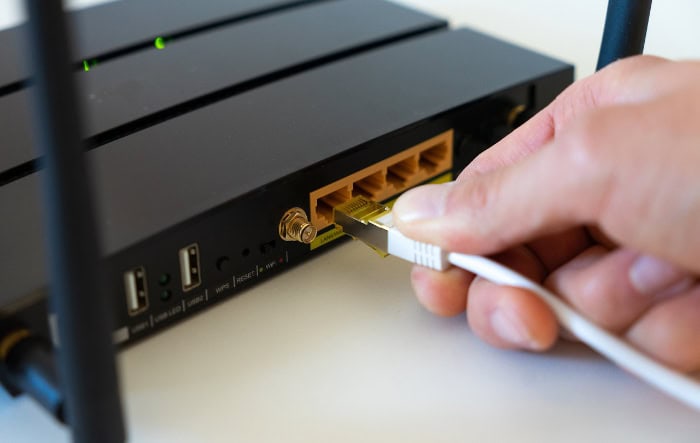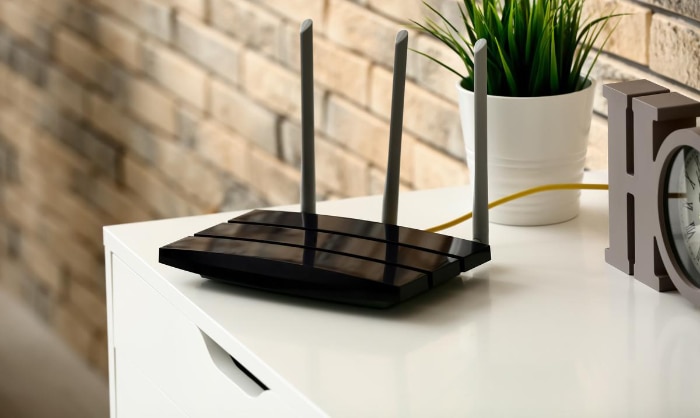What Is Bridge Mode on a Router? All You Should Know

If you’ve ever battled sluggish online gaming, mysterious connection drops, or a frustrating “Double NAT Detected” error, your network setup might be the culprit. These issues often arise when two devices, like an ISP-provided modem and your personal router, are both trying to manage internet traffic.
This redundancy creates conflicts and performance bottlenecks that can disrupt your connection. The fix is a simple but powerful setting called bridge mode.
What Is Bridge Mode?
Bridge mode is a setting that fundamentally changes a router’s behavior, converting it from a network manager into a simple pass-through device. When you have two routers operating on the same network, such as an ISP-provided gateway and a personal router, they can often interfere with each other.
Enabling bridge mode on one of them resolves these conflicts by disabling its routing capabilities, which allows a single, primary router to manage all your internet traffic efficiently.
Disabling Core Router Functions
A typical router performs several critical tasks, including NAT (Network Address Translation) to manage device connections, DHCP (Dynamic Host Configuration Protocol) to assign local IP addresses, and a firewall to provide security. When you enable bridge mode on a router, it deactivates all these functions.
The device stops acting as a router at Layer 3 of the network model and instead operates as a bridge at Layer 2. It no longer routes traffic using IP addresses; instead, it simply forwards data packets to the correct device on the network using their physical MAC addresses.
Centralizing Network Control
The most significant outcome of using bridge mode is the elimination of a problem called double NAT. This issue arises when two routers on the same network both try to manage private IP addresses, creating two separate and conflicting internal networks.
Double NAT is a common source of trouble for online gaming, port forwarding, and VPN connections. By activating bridge mode on your ISP gateway, it passes the public IP address it receives from your provider directly to your personal router.
Your router then becomes the single point of control for the entire network, handling all security, traffic management, and IP address assignments.
Improving Network Performance
By creating a single, streamlined path for data, bridge mode helps reduce latency and prevent errors caused by redundant network processing. With only one router managing the flow of traffic, the connection becomes more stable and reliable, especially for activities that are sensitive to lag, like video calls and streaming.
It is important to recognize that bridge mode does not increase your internet plan’s maximum download or upload speeds. The performance gain comes from optimizing your internal network, not from boosting your external bandwidth.
When to Use Bridge Mode

Activating bridge mode is a strategic move for solving specific network problems and enhancing your home or office setup. It is not a setting you need to change without reason, but in certain situations, it provides a clean and effective solution.
Its use cases range from integrating better hardware into your network to simply making your existing connections more reliable for demanding tasks.
Integrating a High-Performance Router
Many internet service providers supply a combination modem and router unit that often lacks the advanced features and performance of a dedicated third-party router. If you have purchased a new router for its superior Wi-Fi range, enhanced security options, Quality of Service (QoS) controls, or more granular parental settings, bridge mode is essential.
By placing the ISP’s gateway into bridge mode, you effectively turn it into a simple modem. This allows your powerful new router to connect directly to the internet and manage your entire network without any conflicts.
Expanding Wi-Fi Coverage
In larger homes or multi-floor offices, a single router may not be enough to provide a strong Wi-Fi signal everywhere. If you have an older or spare router, you can use it to eliminate these dead zones.
By configuring the extra router in bridge mode and connecting it to your main router, it transforms into a wireless access point. It extends your existing Wi-Fi network’s signal without creating a second, separate network, allowing your devices to connect seamlessly as you move around the building.
Resolving Latency and Connection Issues
Activities like online gaming, VoIP calls, and VPN connections require a stable, low-latency connection that can be disrupted by double NAT. When two routers on a network are both trying to manage traffic, these sensitive applications often suffer from lag, connection errors, or outright failure.
For gamers, this can result in a “Strict” or “Moderate” NAT type, limiting their ability to connect with other players. Enabling bridge mode on one of the routers eliminates double NAT, creating a direct and stable path for data that significantly improves performance for these applications.
How Bridge Mode Compares to Other Setups
The networking world uses several terms that can seem similar, leading to confusion when you are configuring your equipment. Bridge mode, router mode, IP passthrough, and access point mode all describe different ways a device can behave on your network.
Bridge Mode vs. Router Mode
The most fundamental comparison is between a device’s standard router mode and bridge mode. In its default router mode, the device acts as the brain of your network.
It manages traffic between the internet and your devices, assigns local IP addresses through DHCP, translates those addresses with NAT, and protects your network with a built-in firewall. It operates at Layer 3 of the network stack, making routing decisions based on IP addresses.
When switched to bridge mode, the device relinquishes all of those management responsibilities. It becomes a simple, passive conduit that operates at Layer 2, forwarding data to other devices based on their physical MAC addresses without inspecting or altering the packets.
Bridge Mode vs. IP Passthrough
Bridge mode and IP passthrough are often used to achieve the same goal: avoiding double NAT by passing a public IP address to a secondary router behind the main gateway. While functionally similar, the terms are not always interchangeable, as their implementation can vary significantly by manufacturer.
Some vendors use the term “bridge mode” for a feature that completely disables all routing functions. Others, particularly some ISPs, offer an “IP Passthrough” setting that accomplishes a similar outcome but may leave some minimal routing functions active on the gateway.
For most users, the effect is nearly identical, but the subtle differences can matter for advanced setups. It is always best to consult your device’s documentation to see exactly what its specific setting does.
Bridge Mode vs. Access Point and Mesh Systems
The distinction here is about primary purpose. Bridge mode is a setting used to stop a router from performing its routing functions, usually to resolve a network conflict.
An access point (AP), by contrast, is a device specifically designed to create or extend wireless network coverage. Many modern routers offer a dedicated “AP Mode,” which disables routing functions like DHCP and NAT, essentially making it function like a bridged device used for Wi-Fi.
Mesh systems are a more sophisticated evolution of this concept. A mesh network uses multiple nodes that work together to create a single, unified Wi-Fi network with seamless roaming. While a router in bridge mode can serve as a makeshift access point, it lacks the intelligent coordination and client handoff capabilities of a purpose-built AP or mesh system.
How to Safely Set Up Bridge Mode

Configuring bridge mode is a straightforward process, but it requires careful attention to detail and a specific order of operations to prevent network outages. Taking a methodical approach ensures a smooth transition and helps you avoid common configuration errors.
Designate and Configure Your Routers
First, you must decide which device will be your primary router and which will be placed into bridge mode. Your primary router should be the more powerful or feature-rich of the two, as it will manage your entire network.
The device to be bridged is typically the gateway provided by your ISP. Access the administrative settings of the ISP gateway by typing its IP address into a web browser.
Locate the option for “Bridge Mode,” which may also be labeled as “Transparent Bridging” or “IP Passthrough.” Once you enable this setting and save the changes, the device will likely restart.
This action disables its routing functions and prepares it to pass the public IP address directly to your main router.
Connect the Hardware Correctly
Proper physical connections are critical for a bridged setup to work. Once the secondary device has restarted in bridge mode, connect an Ethernet cable from one of its LAN ports to the WAN (or “Internet”) port on your primary router.
A common mistake is connecting the WAN port of the bridged device to the WAN port of the primary router, which will not work and can cause connectivity problems. The goal is to treat the bridged device like a simple modem.
Also, ensure that the DHCP server on the bridged device is disabled; only your primary router should be assigning IP addresses to your devices.
Verify the Configuration and Finalize the Setup
After connecting the hardware, it is time to confirm everything is working as intended. Connect a computer or smartphone to your primary router’s network and check for internet access.
You should then log in to your primary router’s administrative interface. From there, verify that it has received a public IP address on its WAN port, not a private one (like 192.168.x.x).
You can also check its DHCP client list to confirm it is successfully assigning local IP addresses to your connected devices. Finally, test the applications that were previously causing issues, such as online games or VPNs, to ensure that any double NAT warnings have disappeared.
Common Pitfalls and How to Fix Them
While enabling bridge mode can greatly improve your network’s performance, the process can introduce new problems if not done correctly. Most issues that arise during this transition are due to simple configuration oversights rather than hardware failures.
Loss of Features on the Bridged Device
When you switch a router to bridge mode, you are effectively turning off all its intelligent features. Any settings you relied on, such as its firewall, parental controls, Quality of Service (QoS) rules, or guest Wi-Fi networks, will be disabled.
This is not a malfunction but an intended consequence of the mode. The solution is to ensure your primary router can replicate these functions.
Before making the switch, review the features you use on your ISP gateway and confirm that your personal router offers comparable or better alternatives. You will need to configure these settings on the primary router after the bridged network is up and running.
Network-Wide Configuration Conflicts
One of the most disruptive and common misconfigurations is leaving multiple DHCP servers active on the same network. If both the bridged device and the primary router are trying to assign IP addresses, your devices will become confused, leading to intermittent connections or a complete network outage.
Another potential issue is a switching loop, which can occur if you wire the routers incorrectly, for example by connecting two LAN ports between the devices. This error can flood your network with traffic and bring it to a halt.
To prevent these problems, always ensure DHCP is disabled on the device you intend to bridge and follow the correct LAN-to-WAN physical connection topology.
Verifying Network Performance After Setup
Simply having internet access after the change does not mean the configuration was a complete success. The final step is to test for the specific issues you were trying to solve.
If double NAT was causing problems, check your gaming console’s network settings to confirm you now have an “Open” NAT type. If you rely on remote access to a device at home, test your port forwarding rules to ensure they work as expected.
You should also verify that any VPN connections are stable and that real-time streaming services operate without interruption. Running these tests confirms that bridge mode has resolved the underlying issue and your network is truly optimized.
Conclusion
Bridge mode provides a direct solution to many common network headaches, from double NAT errors to performance bottlenecks. By concentrating all routing responsibilities onto a single, primary device, you create a more streamlined and logical network structure.
This setup allows you to combine the necessary hardware from your internet provider with the superior performance and features of a high-quality personal router. It also offers a practical way to repurpose older equipment to extend your Wi-Fi coverage.
Ultimately, a properly configured bridged network results in a more stable, reliable, and easier-to-manage connection for all your activities, from work and streaming to online gaming.


